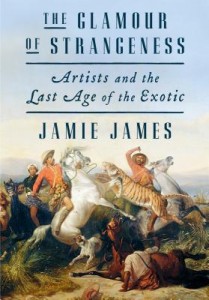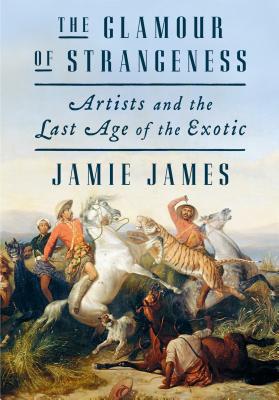 The Glamour of Strangeness: Artists
The Glamour of Strangeness: Artists
and the Last Age of the Exotic
by Jamie James
Farrar, Straus and Giroux
364 pages, $30.
THIS BOOK STARTED OFF by raising my hopes. Acknowledging that “the biographer’s attempt to extract a truthful portrait of a life from the record is difficult enough without trying to whittle it into shape to fit a factitious hypothesis,” James seemed to promise that he would not try to contort his subjects to fit any Procrustean bed of theory. “Yay!” I thought.
He also confessed that one of the first books to catch his childhood imagination was a compilation of Richard Halliburton’s works, the same author whose Royal Road to Romance (1925) I repeatedly read while in grade school. For the unfortunate uninitiated: Halliburton was a well-to-do young man who, upon graduating from Princeton in 1921, set off on limited funds to visit many of the romantic sites about which tales had captivated his youthful fancies. His series of travel books, supplemented with amateur photographs, captured the imagination of Americans who, after World War I, began to dream of seeing the globe described by returning veterans. This book would not only be theory-free, it would offer romance.
But it was not to be. The book presents more-or-less chronological biographical sketches of six artists who attempted to leave behind both their homeland and their cultural identity in order to become part of a radically different culture, one that allowed them to rework their sense of self. “Cultural identity can be a personal choice,” James asserts, “made in defiance of the accident of nationality assigned by birth.” He should know. He has been living with his partner in Indonesia since 1999, though from what he writes, in a fairly Westernized part of it. Of the six artists whose biographies he relates, only one is likely to be familiar to the general reader, the late 19th-century French painter Paul Gauguin. James may have included him to attract a wider audience, because the case he makes for him as someone who truly abandoned his home culture is the weakest of the six.
The other five are: 18th-century Indonesian painter Raden Saleh, who tried to make a life and career for himself in Europe; German painter Walter Spies, a lover of film director F. W. Murnau, who, like James, ended up in Indonesia; French writer and cultural anthropologist Victor Segalen, who spent much time in China; American writer Isabelle Eberhardt, who lived with different peoples in North Africa; and dancer–filmmaker Maya Deren, who became fascinated with the voodoo culture of Haiti. (The last four are all 20th-century figures.)
These biographies are interspersed with sometimes lengthy passages on a variety of other people with whom the six did or did not come in contact: art historian Johann Joachim Winkelmann, traveler Edmund Backhouse, Japanophile Lafcadio Hearn, T. E. Lawrence, early 19th-century English globe trotter Hester Stanhope, choreographer Katherine Durham, and exploiter of Haitian culture Charles Seabrook, among others. In the later chapters, James sometimes seems to deal with anyone who comes to mind while he is writing about his ostensible subject.
None of this necessarily makes for a bad book, if you are looking for a non-scholarly compilation of others’ writings on some rather eccentric individuals who dabbled in the arts, sometimes successfully, sometimes not so much. Unlike Halliburton, who snuck past guards to swim in the reflecting pool of the Taj Mahal under moonlight and sought out the president of Andorra, these individuals break social norms to pursue activities that get them into some awful fixes and then they suffer the consequences, offering the reader few vicarious pleasures.
Nor did James always convince me that his subjects really wanted to live the life of a different culture, despite his assertions to the contrary. I spent several years studying Gauguin, for example, reading all his letters as well as much of the modern scholarship about him. It was always my feeling that, no matter how alienated he became from government authorities in French Polynesia, he never abandoned the dream of returning to the Paris art world in triumph to be hailed as a new and better Monet, the genius who had transformed painting. James asserts that Gauguin demonstrates “a new paradigm, the voluntary exile who goes to distant lands in search of a new home with no intent to repatriate.” Or: “[Gauguin] made a creditable effort to cut his ties to France and immerse himself in his new home.” True, in his last years in Polynesia Gauguin did make more of an effort to immerse himself in its local culture rather than fabricate a synthetic “savage culture” from the books he had brought along with him. But I don’t see how James can ignore Gauguin’s letters showing his continued interest in the Parisian art world.
And then there are the factual errors. For whatever reason, perhaps because he read too much postcolonial theory, James repeatedly derides the work of late 19th-century French novelist and travel writer Pierre Loti. Loti was far better known than any of the featured artists: a Westerner who made a real effort to immerse himself in the local culture while traveling the globe, unlike the Cook’s Tours tourists that he was forever ridiculing. Loti’s early novels, wildly popular in their time, do indeed reproduce some of the cultural prejudices of his day regarding the foreign cultures he visited as a naval officer and later as a private traveler—as did almost every other travel book of his time. In most cases, Loti’s prejudices were mixed with admiration for certain aspects of the lands he described.
If a 21st-century author wants to appear politically correct, he or she can choose not to like Loti’s works. What I find troubling in James’ book is that he repeatedly disparages Loti and his works with comments that show he did not read them, or anything about Loti’s life. This is particularly strange given that several of the subjects whose biographies he sketches, such as Lafcadio Hearn and Isabelle Eberhardt, adored Loti’s work. Might that not have suggested that they were worth an open-minded reading? If James is this careless about a topic I have some knowledge of, I found myself wondering where else he may have been equally careless.
In short, this book is not without its enjoyable passages; just don’t count on any of them being necessarily true.
Richard M. Berrong’s most recent book is Putting Monet and Rembrandt into Words: Pierre Loti’s Recreation and Theorization of Claude Monet’s Impressionism and Rembrandt’s Landscapes in Literature.






